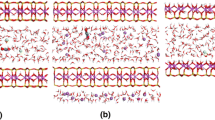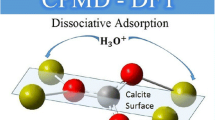Abstract
A better understanding of the thermodynamics of radioactive cesium uptake at the surfaces of phyllosilicate minerals is needed to understand the mechanisms of selective adsorption and help guide the development of practical and inexpensive decontamination techniques. In this work, molecular dynamics simulations were carried out to determine the thermodynamics of Cs+ adsorption at the basal surface of six 2:1 phyllosilicate minerals, namely pyrophyllite, illite, muscovite, phlogopite, celadonite, and margarite. These minerals were selected to isolate the effects of the magnitude of the permanent layer charge (⩽2), its location (tetrahedral vs. octahedral sheet), and the octahedral sheet structure (dioctahedral vs. trioctahedral). Good agreement was obtained with the experiments in terms of the hydration free energy of Cs+ and the structure and thermodynamics of Cs+ adsorption at the muscovite basal surface, for which published data were available for comparison. With the exception of pyrophyllite, which did not exhibit an inner-sphere free energy minimum, all phyllosilicate minerals showed similar behavior with respect to Cs+ adsorption; notably, Cs+ adsorption was predominantly inner-sphere, whereas outer-sphere adsorption was very weak with the simulations predicting the formation of an extended outer-sphere complex. For a given location of the layer charge, the free energy of adsorption as an inner-sphere complex varied linearly with the magnitude of the layer charge. For a given layer charge location and magnitude, adsorption at phlogopite (trioctahedral sheet structure) was much less favorable than at muscovite (dioctahedral sheet structure) due to electrostatic repulsion between adsorbed Cs+ and the H atom of the OH- ion directly below the six-membered siloxane ring cavity. For a given layer charge magnitude and octahedral sheet structure, adsorption to celadonite (octahedral sheet layer charge) was favored over adsorption to muscovite (tetrahedral sheet layer charge) due to the increased distance to the surface K+ ions and the decreased distance to the O atom of the OH- ion directly below the surface cavity.
Similar content being viewed by others

References
Cygan, R.T., Liang, J.-J., and Kalinichev, A.G. (2004) Molecular models of hydroxide, oxyhydroxide, and clay phases and the development of a general force field. Journal of Physical Chemistry B, 108, 1255–1266.
Drits, V.A., Zviagina, B.B., McCarty, D.K., and Salyn, A.L. (2010) Factors responsible for crystal-chemical variations in the solid solutions from illite to aluminoceladonite and from glauconite to celadonite. American Mineralogist, 95, 348–361.
Ewald, P.P. (1921) Die Berechnung Optischer und Elektrostatischer Gitterpotentiale. Annalen der Physik, 64, 253–287.
Geatches, D.L. and Wilcox, J. (2014) Ab initio investigations of dioctahedral interlayer-deficient mica: modelling 1 M polymorphs of illite found within gas shale. European Journal of Mineralogy, 26, 127–144.
Greathouse, J.A. and Cygan, R.T. (2006) Water structure and aqueous uranyl(VI) adsorption equilibria onto external surfaces of beidellite, montmorillonite, and pyrophyllite: Results from molecular simulations. Environmental Science & Technology, 40, 3865–3871.
Guggenheim, S. and Bailey, S.W. (1975) Refinement of the margarite structure in subgroup symmetry. American Mineralogist, 60, 1023–1029.
Hernández-Laguna, A., Escamilla-Roa, E., Timón, V., Dove, M.T., and Sainz-Díaz, I.C. (2006) DFT study of the cation arrangements in the octahedral and tetrahedral sheets of dioctahedral 2:1 phyllosilicates. Physics and Chemistry of Minerals, 33, 655–666.
Hoover, W.G. (1985) Canonical dynamics — equilibrium phase-space distributions. Physical Review A, 31, 1695–1697.
Horinek, D., Mamatkulov, S.I., and Netz, R.R. (2009) Rational design of ion force fields based on thermodynamic solvation properties. Journal of Chemical Physics, 130, 124507.
Hummer, G., Pratt, L.R., and Garcia, A.E. (1997a) Ion sizes and finite-size corrections for ionic-solvation free energies. Journal of Chemical Physics, 107, 9275–9277.
Hummer, G., Pratt, L.R., Garcia, A.E., Berne, B.J., and Rick, S.W. (1997b) Electrostatic potentials and free energies of solvation of polar and charged molecules. Journal of Physical Chemistry B, 101, 3017–3020.
Kastenholz, M.A. and Hünenberg, P.H. (2006a) Computation of methodology-independent ionic solvation free energies from molecular simulations. I. The electrostatic potential in molecular liquids. Journal of Chemical Physics, 124, 124106.
Kastenholz, M.A. and Hünenberg, P.H. (2006b) Computation of methodology-independent ionic solvation free energies from molecular simulations. II. The hydration free energy of the sodium cation. Journal of Chemical Physics, 124, 224501.
Kato, H., Onda, Y., and Teramage, M. (2012) Depth distribution of 137Cs, 134Cs, and 131I in soil profile after Fukushima Dai-ichi nuclear power plant accident. Journal of Environmental Radioactivity, 111, 59–64.
Kozai, N., Ohnuki, T., Arisaka, M., Watanabe, M., Sakamoto, F., Yamasaki, S., and Jiang, M. (2012) Chemical states of fallout radioactive Cs in the soils deposited at Fukushima Daiichi Nuclear Power Plant accident. Journal of Nuclear Science and Technology, 49, 473–478.
Lee, J.H. and Guggenheim, S. (1981) Single crystal X-ray refinement of pyrophyllite-1 TC. American Mineralogist, 66, 350–357.
Lee, S.-S., Fenter, P., Park, C., Sturchio, N.C., and Nagy, K.L. (2010) Hydrated cation speciation at the muscovite (001)-water interface. Langmuir, 26, 16647–16651.
Lee, S.-S., Fenter, P., Nagy, K.L., and Sturchio, N.C. (2012) Monovalent ion adsorption at the muscovite (001)-solution interface: Relationships among ion coverage and speciation, interfacial water structure, and substrate relaxation. Langmuir, 28, 8637–8650.
Lee, S.-S., Fenter, P., Nagy, K.L., and Sturchio, N.C. (2013) Changes in adsorption free energy and speciation during competitive adsorption between monovalent cations at the muscovite (001)-water interface. Geochimica et Cosmochimica Acta, 123, 416–426.
Liang, J.-J. and Hawthorne, F.C. (1996) Rietveld refinement of micaceous materials: Muscovite-2M1, a comparison with single-crystal structure refinement. Canadian Mineralogist, 34, 115–122.
Mähler, J. and Persson, I. (2012) A study of the hydration of the alkali metal ions in aqueous solution. Inorganic Chemistry, 51, 425–438.
Marcus, Y. (1991) Thermodynamics of solvation on ions. Part 5. — Gibbs free energy of hydration at 298.15 K. Journal of the Chemical Society — Faraday Transactions, 87, 2995–2999.
Melchionna, S., Ciccotti, G., and Holian, B.L. (1993) Hoover NPT Dynamics for Systems Varying in Shape and Size. Molecular Physics, 78, 533–544.
Meleshyn, A. (2008) Aqueous solution structure at the cleaved mica surface: Influence of K+, H3O+, and Cs+ adsorption. Journal of Physical Chemistry C, 112, 20018–20026.
Momma, K. and Izumi, F. (2011) VESTA 3 for threedimensional visualization of crystal, volumetric and morphology data. Journal of Applied Crystallography, 44, 1272–1276.
Okumura, M., Nakamura, H., and Machida, M. (2013) Mechanism of strong affinity of clay minerals to radioactive cesium: First-principles calculation study for adsorption of cesium at frayed edge sites in muscovite. Journal of the Physical Society of Japan, 82, 033802.
Okumura, M., Nakamura, H., and Machida, M. (2014) Energetics of atomic level serial ion exchange for cesium in micaceous clay minerals. Clay Science, 18, 53–61.
Pabst, A. (1955) Redescription of the single layer structure of the micas. American Mineralogist, 40, 967–974.
Qin, H., Yokoyama, Y., Fan, Q., Iwatani, H., Tanaka, K., Sakaguchi, A., Kanai, Y., Zhu, J., Onda, Y., and Takahashi, Y. (2012) Investigation of cesium adsorption on soil and sediment samples from Fukushima Prefecture by sequential extraction and EXAFS technique. Geochemical Journal, 46, 297–302.
Rosso, K.M., Rustad, J.R., and Bylaska, E.J. (2001) The Cs/K exchange in muscovite interlayers: An ab initio treatment. Clays and Clay Minerals, 49, 500–513.
Sakuma, H. and Kawamura, K. (2009) Structure and dynamics of water on muscovite mica surfaces. Geochimica et Cosmochimica Acta, 73, 4100–4110.
Sakuma, H. and Kawamura, K. (2011) Structure and dynamics of water on Li+-, Na+-, K+-, Cs+-, H3O+-exchanged muscovite surfaces: A molecular dynamics study. Geochimica et Cosmochimica Acta, 75, 63–81.
Schlegel, M.L., Nagy, K.L., Fenter, P., Cheng, L., Sturchio, N.C., and Jacobsen, S.D. (2006) Cation sorption on the muscovite (001) surface in chloride solutions using high-resolution X-ray reflectivity. Geochimica et Cosmochimica Acta, 70, 3549–3565.
Schwenk, C.F., Hofer, T.S., and Rode, B.M. (2004) “Structure breaking” effect of hydrated Cs+. Journal of Physical Chemistry A, 108, 1509–1514.
Smith, W. and Forester, T.R. (1996) DL_POLY_2.0: A general purpose parallel molecular dynamics simulation package. Journal of Molecular Graphics, 14, 136–141.
Tanaka, K., Takahashi, Y., Sakaguchi, A., Umeo, M., Hayakawa, S., Tanida, H., Saito, T., and Kanai, Y. (2012) Vertical profiles of iodine-131 and cesium-137 in soils in Fukushima Prefecture related to the Fukushima Daiichi Nuclear Power Station Accident. Geochemical Journal, 46, 73–76.
Wang, J., Kalinichev, A.G., Kirkpatrick, R.J., and Cygan, R.T. (2005) Structure, energetics, and dynamics of water adsorbed on the muscovite (001) surface: A molecular dynamics simulation. Journal of Physical Chemistry B, 109, 15893–15905.
Author information
Authors and Affiliations
Corresponding author
Rights and permissions
About this article
Cite this article
Kerisit, S., Okumura, M., Rosso, K.M. et al. Molecular Simulation of Cesium Adsorption at the Basal Surface of Phyllosilicate Minerals. Clays Clay Miner. 64, 389–400 (2016). https://doi.org/10.1346/CCMN.2016.0640405
Received:
Revised:
Published:
Issue Date:
DOI: https://doi.org/10.1346/CCMN.2016.0640405



